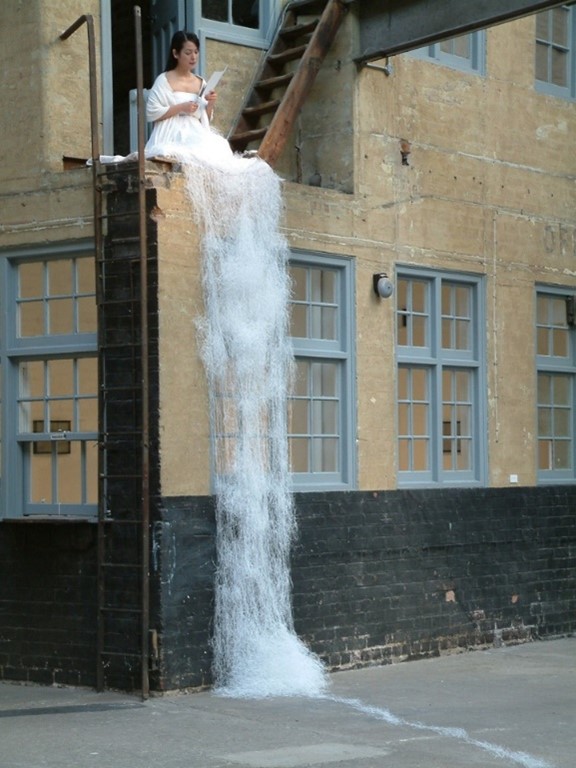Introduction:
Art has been regarded as healing since time immemorial. It is immersive, can help work through emotions, and even be calming. The serenity offered by art stems from the process, often repetitive, familiar, and soothing. This sense of stillness experienced by the artist often extends to the viewer- allowing them to feel the tranquillity of creating the piece. It is this facet of art that is incorporated in the works of Sachiko Abe, the Japanese artist who makes installations featuring hours of cut paper arranged to depict waterfall-like fluidity. Adding to the immersive experience is the lack of all sounds, but that of cutting itself.
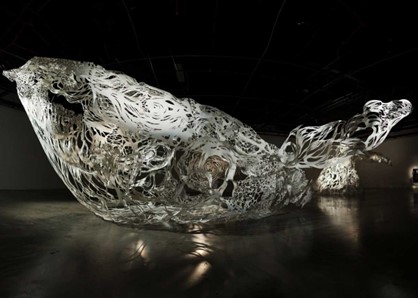
Source: Japan Objects
The Work of Sachiko Abe:
Born in 1975, Abe has attributed her interest in cutting paper due to its meditative nature. She first began cutting paper at around twenty years old, as it calmed her mind when admitted to an institution and helped her avoid causing bodily harm to herself. Decades later, her pieces feature her sitting on an elevated surface cutting delicate strips of paper as the audience watches her at work for hours. She has produced several performance art installations and drawings, but her piece Cut Papers remains the most well-known.
When she first began working with paper, she reportedly cut for 10 hours a day for 14 years- leading to the use of 42, 700 sheets of paper. Each sheet is said to have taken her approximately 40 minutes to cut. The strands she cuts are about 0.5 mm in width, with some sources reporting a changing range of thickness causing the paper strands to be thicker at around 1mm. Her recent installation of the work at the Liverpool Biennial showcases the cascading strands of paper from the balcony she sits at, starting a trail of paper leading to a massive cone-like accumulation of all the paper she has cut over the years. The arrangements of Abe’s paper cuttings have been described as resembling delicate snow, cobwebs, and even fur. The larger structure even appears to be a massive icicle from a distance.
She also uses microphones to amplify the sound of cutting- the only sound in the installation- allowing a peaceful, rhythmic background for the spectators. The artist also notes that the process not only allows her peace but also the organization of her mind and her thoughts. She says, “The rhythm of the scissors, the fineness, and the length of the paper strip correspond to the process of my thinking, and its effect on the body. While essentially personal, Cut Papers is a necessary practice for me to formulate my relationship to the external world.” Abe’s works have been on display at prominent galleries and exhibitions including the Liverpool Biennial (UK), MoMA PS1 in New York, Towada and Kyoto Art Centres (Japan), Schirn Kunsthalle (Germany) and Baltic Gateshead (UK).
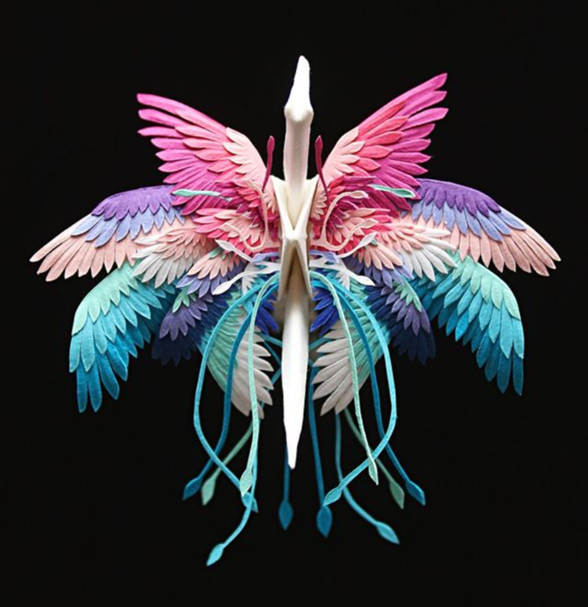
Source: My Modern Met
Paper Cutting: An Artform
Paper cutting that Abe employs, has been a long-explored art form, with many forms of its existence being observed in traditional Japanese and Chinese crafts. Kirigami or Kirie, for example, involve folding and cutting paper to create intricate pieces without using glue. Kirigami, as it was coined in the States, has roots in jianzhi, the process of cutting intricate shapes on coloured paper as a way honouring gods. They also had a decorative purpose and have been observed in China as far back as the 6th century. Kirie in ancient Japan was made possible due to the availability of washi tape. The older form of the art called kamikiri was also performance based- elaborate cuttings were made on paper in front of an audience with music playing in the background. While the artform has since become more of an individual pursuit, its careful craftspersonship and attention to detail remains.
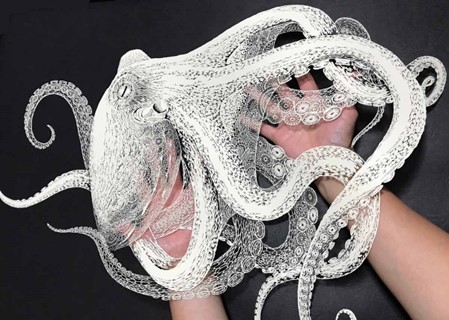
Source: Japan Objects
Kirigami Today: Modern Day Artists
Kirigami is as modern as it is traditional, with many modern-day artists evolving the style of the form. Detailed, flat cut outs are made with extremely skilled precision by artists like Masayo Fukada and Kanako Abe while artist Zai Divecha incorporates both folding and cutting aspects to create paper sculptures. The works of Cristian Marianciuc expands the sculpture to include multiple sheets of coloured, cut paper over the traditional single one- he layers them all together to create three-dimensional paper crane models.
Elaborate, large-scale models too, have been entirely constructed out of paper by Kirigami artists. Ayumi Shibata creates entire cities, complete with buildings, layers of vegetation, windows and roads using white paper. She believes strongly in the sacredness of paper as per the Shinto religion, conveying it through the intricate constructions. The artist also incorporates light into her pieces, as seen in her smaller works and even in ‘Paper World’- a massive, carefully crafted work across a wall, depicting a many layered cave-like structure. Nahoko Kojima is another artist who has secured international recognition for her paper cutting, having worked with brands such as Bulgari, adding to their stores and shows with her art. In her Bangkok exhibition, she created large doves with thinly cut feathers that were suspended for the audience to see. Shapes and patterns like that of hearts were hidden within the feathers. Kojima’s work featured long, wispy strands of paper that come together to create the pieces, including chains of birds with heart-shaped parts. She has had her work displayed at the Holburne Museum in Bath, UK and hosted a Dubai show titled ‘Kirie Master Kojima’.
Traditional artforms survive due to the collective efforts of a civilisation. As seen in the case of paper cutting, a multitude of artists have taken up, transformed, and adapted it in their own ways to both help it survive and to allow its growth. Sachiko Abe’s paper cutting focuses on the process than the result- there is emphasis on finding rhythm and a serenity in accepting the simple act of precise paper cutting. The artists who make illustrious two-dimensional pieces work to craft an image, and the sculpture pieces assimilate form, light and shadow. The beauty of all these pieces lies in the patience required to create them, the stories of the artists and like in the case of Sachiko Abe, why they make what they make in the first place. Finally, what also matters is what has been shared with the audience, the environment they are given and the tales of paper they are free to interpret.
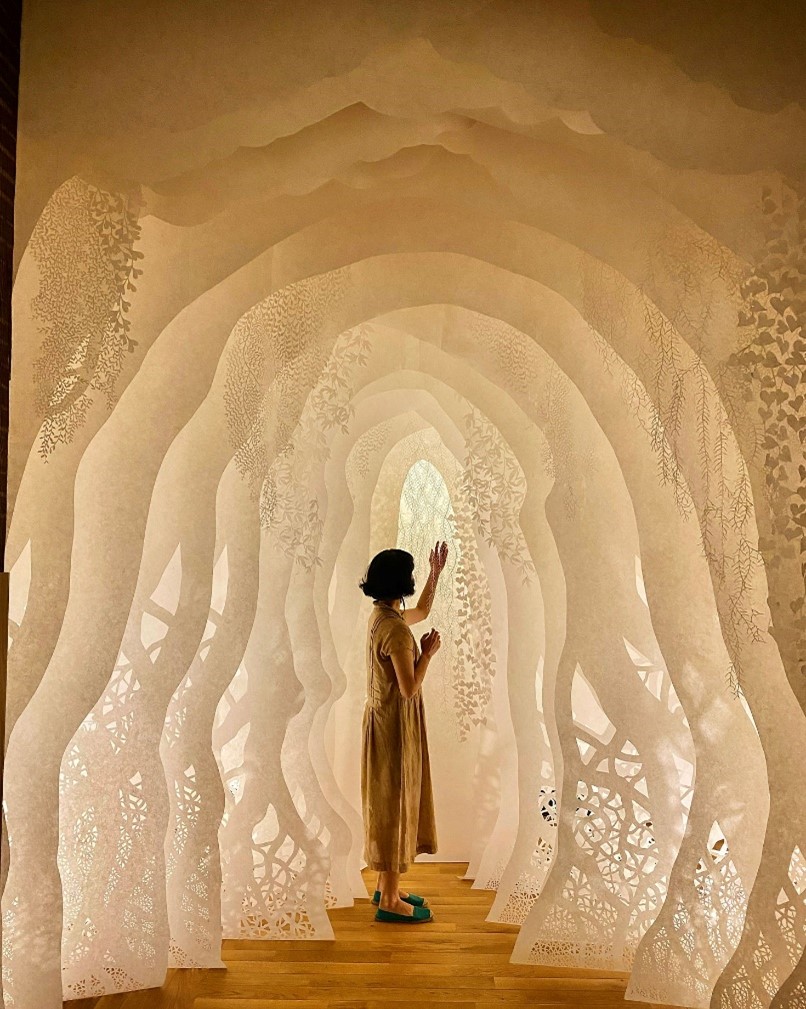
Source: Ayumi Shibata
SOURCES:
https://www.rituals.com/en-nl/mag-rituality-leaving-a-paper-trail.html
https://www.artinliverpool.com/art-review/sachiko-abe-at-a-foundation/
https://mymodernmet.com/sachiko-abe-cut-paper/
https://mymodernmet.com/kirigami/
https://japanobjects.com/features/kirie
Feature image Courtesy:
Sachiko Abe, ‘Cut Paper’, Liverpool Biennele
Source: My Modern Met

Contributor

